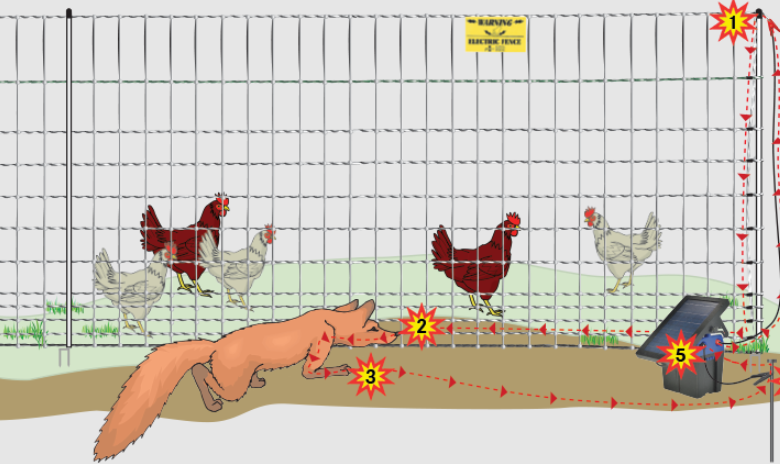Electric Poultry Netting: Ensuring Safety and Efficiency in Modern Farming

Electric poultry netting is a marvel of agricultural engineering, incorporating various components such as conductive wires, insulators, and energizers. Its design is tailored to deter predators while keeping the poultry safe within its confines. The intricate mesh patterns and height variations are crucial design elements that cater to different poultry breeds and farm layouts.
Advantages of Electric Poultry Netting
Enhancing Farm Safety
Safety is a top priority in poultry farming, and electric netting offers an unparalleled level of protection, poultry farming tips here. It acts as a robust barrier against various threats, including wild animals and trespassers. This enhanced safety translates into peace of mind for farmers, knowing their investment is secure.
Improving Efficiency in Poultry Farming
Efficiency in farming practices is key to sustainability and profitability. Electric poultry netting streamlines the management of poultry, reducing the time and resources needed for supervision and maintenance. It also minimizes the risk of escape, ensuring that the birds remain within designated areas, thus optimizing farming operations.
Installation Guide for Electric Poultry Netting
Step-by-Step Installation Process
Installing electric poultry netting requires careful planning and execution. This section provides a detailed guide, covering everything from selecting the right location to connecting the energizer. Each step is crucial in ensuring that the netting performs optimally, providing the best protection for the poultry.
Tips for Safe and Effective Setup
Safety is paramount during installation. This part of the article offers practical tips and best practices to ensure a safe and effective setup. It emphasizes the importance of following manufacturer guidelines and taking necessary precautions to prevent accidents during the installation process.
Maintenance and Care of Electric Poultry Netting
Routine Checks and Maintenance Tips
Regular maintenance is essential to keep electric poultry netting in top condition. This segment outlines a routine maintenance schedule and provides tips on inspecting and repairing the netting. Proper care extends the lifespan of the netting and ensures consistent performance.
Long-term Durability and Care
The durability of electric poultry netting is a key factor in its appeal. This section delves into the factors that contribute to its longevity, such as material quality and resistance to environmental factors. It also offers advice on long-term care and storage practices to maximize the netting’s lifespan.
Regulatory Compliance and Safety Standards
Understanding Local Regulations
Compliance with local regulations is crucial in the installation and use of electric poultry netting. This part of the article explores the various legal requirements and standards that must be met, helping farmers navigate the complexities of regulatory compliance.
Meeting Safety Standards for Poultry Netting
Safety standards are in place to protect both the poultry and the people working on the farm. This section details the industry standards for electric poultry netting, including specifications for electrical components and structural integrity. Adhering to these standards ensures the safety and well-being of all involved.
Cost-Benefit Analysis of Electric Poultry Netting
Initial Investment vs Long-term Benefits
Investing in electric poultry netting involves an upfront cost, but the long-term benefits far outweigh this initial expenditure. This analysis compares the costs associated with electric netting to those of traditional methods, highlighting the savings in terms of reduced losses, lower maintenance costs, and improved efficiency.
Compared with Traditional Poultry Netting Solutions
This comparison provides a clear picture of how electric poultry netting stands out from traditional netting solutions. It focuses on aspects such as durability, effectiveness, and ease of use, demonstrating why electric netting is a superior choice for modern poultry farming.
Identifying and Solving Operational Challenges
Even the best systems can encounter problems. This section addresses common issues that may arise with electric poultry netting, such as power failures or damage to the netting. It offers practical solutions and troubleshooting tips to quickly resolve these challenges.
Expert Tips for Quick Fixes
Drawing on the expertise of industry professionals, this part provides valuable insights and quick-fix tips for maintaining the optimal performance of electric poultry netting. These tips are designed to help farmers address issues efficiently, minimizing downtime and ensuring continuous protection for their flocks.
Sustainability and Eco-Friendly Practices
Electric Netting and Environmental Impact
Sustainability is a growing concern in all areas of agriculture. This section examines the environmental impact of electric poultry netting, discussing its energy efficiency and compatibility with eco-friendly farming practices. It highlights how electric netting contributes to sustainable agriculture by reducing the need for chemical deterrents and promoting natural farming methods.
Adopting Green Practices in Poultry Farming
Embracing eco-friendly practices is essential for the future of farming. This part of the article explores ways in which poultry farmers can integrate sustainable practices into their operations, focusing on energy conservation, waste reduction, and responsible resource management. It underscores the role of electric poultry netting in facilitating these green initiatives.
Expert Opinions and Industry Insights
Interviews with Poultry Farming Experts
Expert opinions add depth and credibility and authority to any discussion. This section features interviews with seasoned poultry farming experts, sharing their insights on the benefits and challenges of electric poultry netting. Their perspectives offer a rich understanding of the practical aspects and future potential of this technology in the farming industry.
Future Trends in Poultry Netting Solutions
The future of poultry farming is constantly evolving. Here, industry experts share their predictions and insights on upcoming trends and innovations in poultry netting solutions. This forward-looking analysis provides a glimpse into the potential advancements and changes that could shape the future of electric poultry netting in agriculture.
Electric Poultry Netting: Ensuring Safety and Efficiency in Modern Farming
This comprehensive overview dives deep into the myriad benefits of electric poultry netting. It discusses best practices for installation, maintenance, and usage, ensuring that farmers can maximize the potential of this technology in their operations.
The Integral Role in Modern Poultry Farming
Electric poultry netting plays a crucial role in the modernization of poultry farming. This section highlights its significance in improving the overall safety, efficiency, and sustainability of poultry farming practices, marking it as an essential component in the modern farmer’s toolkit.
Emerging Technologies in Poultry Farming
The agricultural sector is continually innovating, and poultry farming is no exception. This segment explores the latest technological advancements and how they integrate with electric poultry netting, potentially enhancing its effectiveness and efficiency.
FAQs
What makes electric poultry netting a safe option for birds?
Electric poultry netting is designed to deter predators without harming the birds. The electric shock is mild and acts as a deterrent, not a harmful force. The netting’s design ensures that the birds are kept safely within the confines of their designated area, significantly reducing the risk of injury or escape.
How does electric poultry netting improve farm efficiency?
Electric poultry netting streamlines poultry management by reducing the need for constant physical monitoring. Its effectiveness in keeping predators out and birds in minimizes losses and damage. This efficiency allows farmers to focus on other important aspects of farm management, thus improving overall productivity.
Can electric poultry netting withstand harsh weather conditions?
Yes, most electric poultry netting is designed to be durable and weather-resistant. It is made of materials that can withstand various environmental conditions, including rain, snow, and extreme temperatures. However, regular maintenance checks are recommended to ensure its integrity and functionality are not compromised by harsh weather.
What are the key maintenance practices for electric poultry netting?
Key maintenance practices include regular inspections for damage or wear, ensuring the energizer is functioning correctly, and keeping the netting free from debris and vegetation that might interfere with its operation. It’s also important to check for and repair any breaks or weak spots in the netting.
How does electric poultry netting align with sustainable farming practices?
Electric poultry netting aligns with sustainable farming by reducing the need for chemical deterrents and allowing for more natural poultry-rearing practices. Its durability and efficiency contribute to a lower carbon footprint and make it a more environmentally friendly option compared to traditional methods.
What should farmers consider before installing electric poultry netting?
Before installation, farmers should consider the size and layout of the area, the type of poultry being reared, local wildlife and predator types, and any specific regulatory requirements. It’s also important to factor in the initial investment cost and the long-term maintenance requirements.
Conclusion
This article emphasizes the critical role that electric poultry netting plays in modern farming. Its contribution to safety, efficiency, and sustainability marks a significant step forward in the evolution of poultry farming. The future of poultry farming looks promising with the adoption of electric netting. As the industry continues to evolve, electric poultry netting will undoubtedly remain a key component in this transformation, ensuring that poultry farms remain safe, efficient, and sustainable for years to come.




